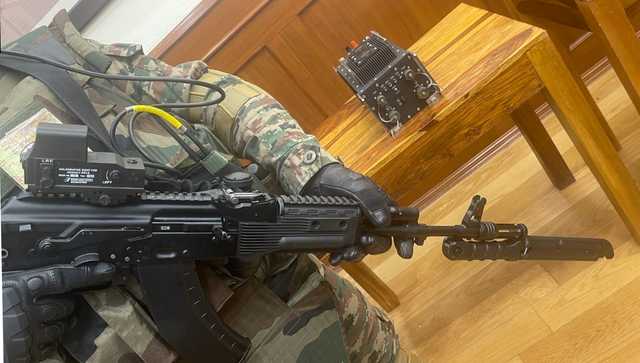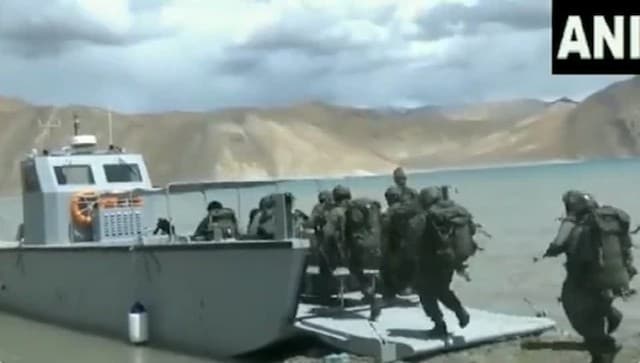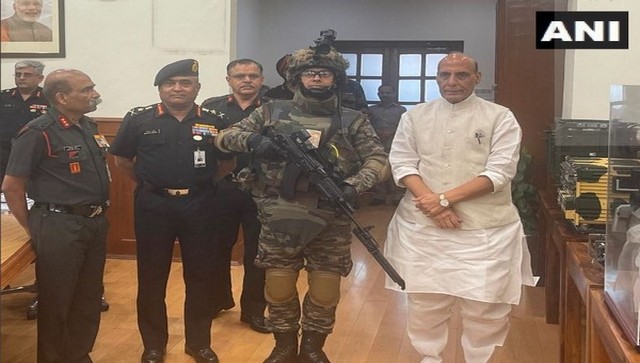Defence minister Rajnath Singh on Tuesday handed over the much-awaited indigenously manufactured Future Infantry Soldier as a System (F-INSAS) to the Indian Army. Army Chief General Manoj Pande and Lt General Harpal Singh were present at the ceremony where the latest anti-personnel mine Nipun, the Made in India Landing Craft Assault (LCA) as well as a drone system to help keep an eye on enemy troops in the forward areas along the Line of Actual control were also handed over. During the ceremony today, an army soldier also briefed Rajnath on the new weapon systems. Rajnath later tweeted: “These systems will enhance the operational preparedness of the Army and help them to deal with future challenges.” But what is are these weapons systems? Let’s take a closer look: What is F-INSAS? The F-INSAS project aims at modernising infantry and enhancing the operational capability of the soldier. Under it, soldiers are to be equipped with modern systems which will be lightweight, all-weather-all-terrain, economical and would require low maintenance. It looks to transform the soldiers deployed in the border areas into ‘a self-contained fighting machine’. [caption id=“attachment_11063371” align=“alignnone” width=“640”]  The F-INSAS system. ANI[/caption] The F-INSAS system includes an AK-203 assault rifle – a Russian-origin gas-operated, magazine-fed, select fire assault rifle with a range of 300 metre – as well as a ballistic helmet, ballistic goggles, a bulletproof jacket, elbow-pads, and knee pads. The helmet and bulletproof jacket offers protection against lethal weapons such as a 9mm bullet even from point blank range and from AK-47 rifle, as per Moneycontrol. Infantry soldiers will also be provided holographic vision mounted on their rifles to aid with target and acquisition with a 200 metre range. F-INSAS also includes a hands-free head-set which will help enhance the operational capabilities of an infantry soldier and improve communication effectively, as per the report.
The F-INSAS will be manufactured in Uttar Pradesh’s Amethi in a joint venture between Indian and Russian entities.
As per Indian Express, the project was conceptualised in the early 2000s by the Defence Research and Development Organisation (DRDO) in line with the targets of the Army’s Infantry Soldier Modernisation Programme with an aim to optimise the soldier’s performance across the full spectrum and duration of a military operation. DRDO scientists said in order to develop F-INSAS, infantry modernisation programmes from the US, France, Germany and Israel were studied and quality requirements set by the army. Anti-personnel landmine Nipun The anti-personnel Nipun landmines are a replacement for the vintage NMM 14 mines. Anti-personnel mines are to be used against humans as against anti-tank mines which are aimed at heavy vehicles.
They are smaller in size and can be deployed in larger numbers.
As per the Centre, they are more potent and effective than the existing anti-personnel mines and will enhance the protection provided to the troops on the borders. The Nipun landmines have been developed by the combined efforts of the Armament Research and Development Establishment, Pune, and the Indian industry. The Landing Craft Assault The Landing Craft Assault (LCA) is a replacement for the boats with ‘limited capabilities’ operating in Pangong Tso lake. [caption id=“attachment_11064941” align=“alignnone” width=“640”]  Indian Army showcasing the capability of the Landing Craft Assault. ANI[/caption] As per the Centre, the LCA is much more versatile and has overcome the limitations of launch, speed and capacity. It has enhanced the capability to operate across the water obstacles in Eastern Ladakh.
LCA has been indigenously developed by M/s Aquarius Ship Yard Limited, Goa.
Experts speak Moneycontrol quoted Lt General Harpal Singh, Engineer-in-Chief of the Indian Army, saying that the Centre has undertaken a number of initiatives to support Make in India in the defence industry. “Different policy decisions have been taken by the Government of India to help promote indigenisation of weapon systems for the Armed Forces. Many new equipment inducted by the Army in this direction including mines, personal weapons and infantry combat vehicles,” he said. Singh added that no matter the threat, whether it comes from the western desert or high-altitude areas in the Ladakh region, the Indian Army is ready to combat it. Speaking to Indian Express on condition of anonymity, a senior Indian Army officer said the aim of F-INSAS is to equip the infantry soldier for the modern-day network-centric warfare scenario. The concept of network-centric warfare denotes the effective use of information technology and computer networking tools to form networks of various force elements in play on the battlefield. The government’s push for indigenous production in the defence sector may be seen as a backdrop for the introduction of indigenous systems. This is in accordance with Prime Minister Narendra Modi’s pledge for Aatmanirbhar Bharat, which has also been translated into efforts by the Ministry of Defense to achieve self-reliance in defence. With inputs from agencies Read all the Latest News , Trending News , Cricket News , Bollywood News , India News and Entertainment News here. Follow us on Facebook, Twitter and Instagram.


)

)
)
)
)
)
)
)
)



